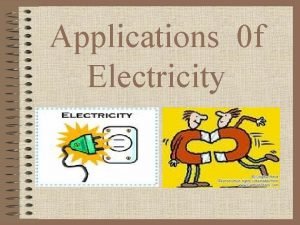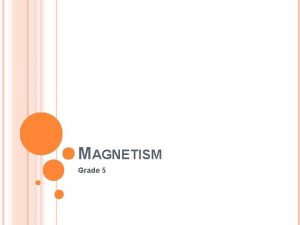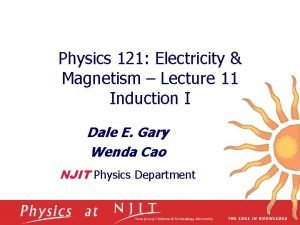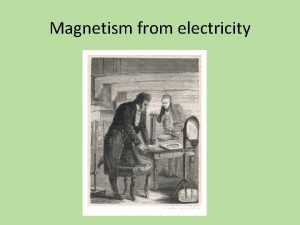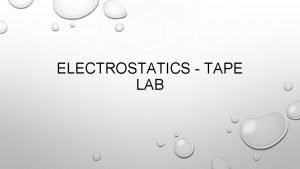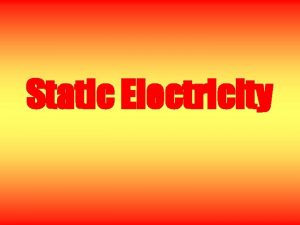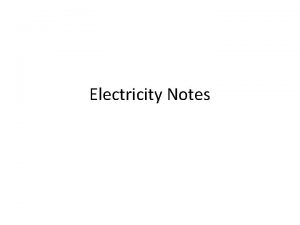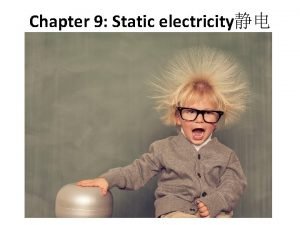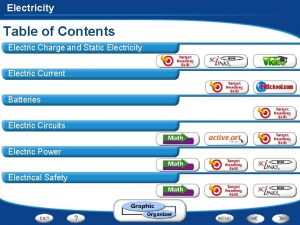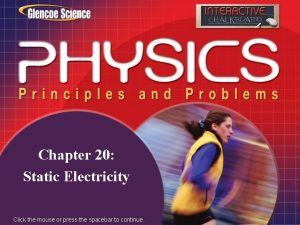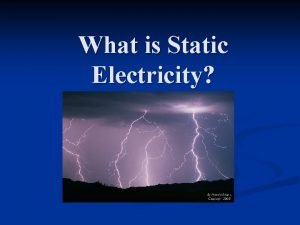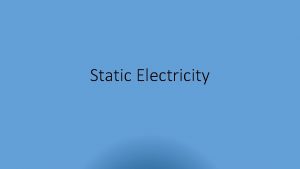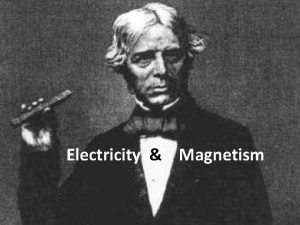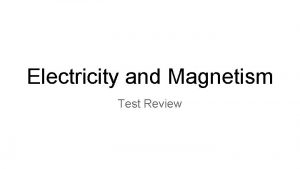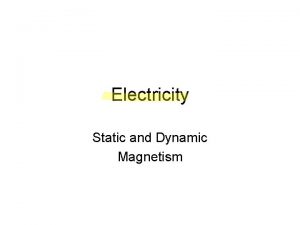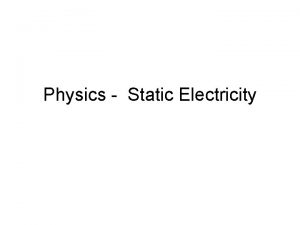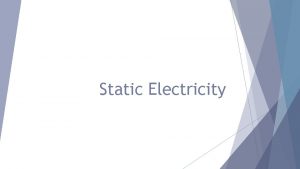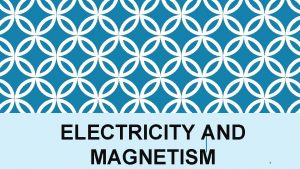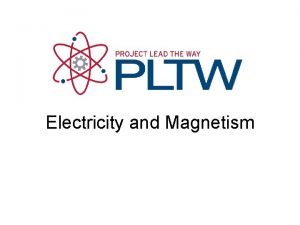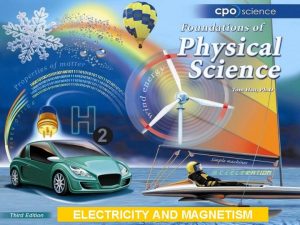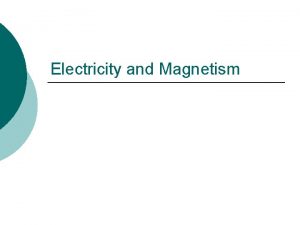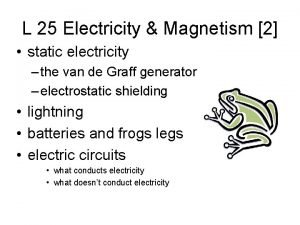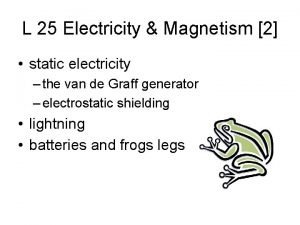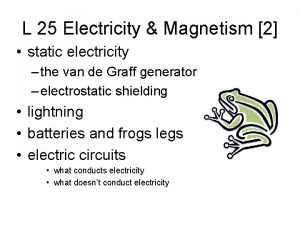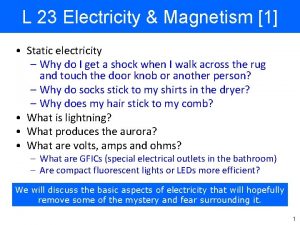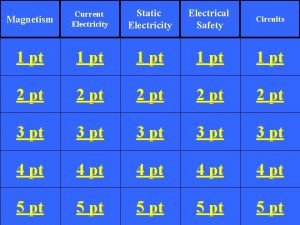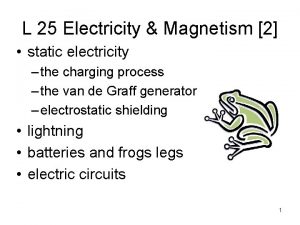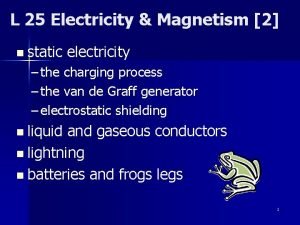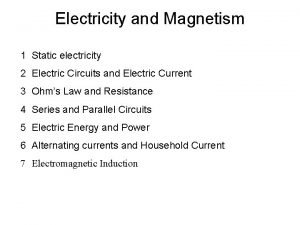Electricity Magnetism Static Electricity 1 What is an



























- Slides: 27

Electricity & Magnetism

Static Electricity 1. What is an electric charge? - tiny particles that make up matter with a charge 2. What effect do positive and negative charges have on one another? - they cancel each other out

3. What does it mean to be negatively charged and positively charged? - negatively charged: has more charges that are negative - positively charged: has more charges that are positive 4. What do you call matter that has a balance of positive and negative charges? -neutral; matter contains equal numbers of positive and negative charges

5. What is one way an object becomes charged? -by being rubbed (friction) 6. Draw the different charges. Positive Charge Negative Charge

6. Describe what happens to charges in a chart below. N P N P

8. What is static electricity? - a buildup of charges in one place. Example: rubbing socks against carpet then touching a metal doorknob 9. What causes the shock when you touch a metal doorknob after walking across a carpet? - a charge jumping/transferring from you to the doorknob

10. Why do you think most objects don’t attract and repel one another? -the objects are neutral

Electric Forces 11. What is an electric force? - the push or pull between two difference objects 12. What is an electric field? -the area around the two electric charges

13. Draw a picture of an electrical field /electrical force. Electrical Field Electrical Force

Circuits 14. Describe an electric current. -a flow of electric charges 15. Explain an electric circuit. -a closed path that current flows through; has a battery and wire

16. Draw a picture of an electrical current. ***Label the parts***

17. How is current electricity different from static electricity? -in currentl electricity, charges keep moving around a circuit; in static electricity, charges separate but not continually move 18. Which is more useful to people? - current electricity is more useful to people because it can be controlled

Series/Parallel Circuit 19. Describe a series circuit. -it has only one path for its current to follow; you can add more than one device; when path is broken, devices will stop working

20. Draw a series circuit. Draw a Series Circuit ***Label the parts*** 21. Can a series circuit have more than one device? What happens if you remove a device in a series circuit? -yes; all the devices stop working b/c the circuit is not longer complete and current cant flow.

22. Why aren’t all lamps and devices in homes wired in a series circuit? -if one goes out or is unplugged, they all go out 23. When you press the switch on a lamp, the light goes off or on. What does the switch do to make this happen? -completes the circuit to make the lamp light work; it opens the circuit to make the lamp turn off

24. Describe a parallel circuit. - has more than one path for the current to follow; the more added to device, the weaker current will be Example: Schools, homes, and business Draw a Parallel Circuit ***Label the parts***

25. How is a parallel circuit different from a series circuit? -a parallel circuit has more than one path that the current can follow; if one path is open or damaged, electricity can flow along the other path; a series circuit has only one path that current can follow 26. Why are devices in homes and schools plugged into sockets rather than being all wired together? -so they can be turned on or off separately

26. In a parallel circuit, what effect does removing one device have on the other device? - it has no effect; the other devices still works

Resistance 27. What is resistance? - how much a material opposes the flow of a current 28. Compare the resistance of thick and thin wires? -thick wires have lower resistance than thin wires

29. Describe a short circuit. -a current takes a shortcut where it isn’t wanted 30. What effect does adding devices have on the resistance of a series circuit? -adding devices increases the total resistance of the circuit

Conductors & Insulators 31. Describe conductor. - is a material in which charges move easily through 32. What makes a good conductor? -metals; copper; silver; salt water; iron; gold; aluminum; steel

33. Describe an insulator. - material that resists the flow or electricity 34. What makes a good insulator? - most plastics; glass; cloth; sand; rubber; wood; dry air

Electromagnets 35. What is an electromagnet? - a temporary magnet that has coils of current running wire around an iron core (nail). 36. How can you make the magnetic field around a current carrying coil of wire stronger? -wrap the coil around an iron core

37. How does the field around a current carrying wire compare to the magnetic filed around a bar magnet? - field lines around a bar magnet loop out from the north seeking end of the magnet to the south seeking end; the field lines around a current carrying wire circle the wire 38. What happens to an electromagnet when you remove the battery or power supply? -the electromagnet will stop working

39. Which is an advantage of a magnet that you can turn off and on? a) they can be turned on and off by turning the current on and off. b) they can be made stronger or weaker by either changing the strength of the battery or by changing the number of wire loops c) the direction of the field can be changed (switching the poles) by switching the ends attached to the battery

40. How can electricity be used to make a magnet? - a wire that carries an electric current has a magnetic field; if you wrap the wire around a nail, the nail become a magnet; the more coils, the stronger the nail. 41. What is the effect of using two batteries instead of one? - the electromagnet get stronger.

42. Difference between electromagnet and bar magnet? -electromagnet is temporary and bar magnet is permanent.
 Electricity and magnetism vocabulary
Electricity and magnetism vocabulary Static electricity and current electricity
Static electricity and current electricity Current electricity gif
Current electricity gif Electricity and magnetism
Electricity and magnetism Magnetism jeopardy
Magnetism jeopardy Electricity and magnetism grade 5
Electricity and magnetism grade 5 4 forces of nature
4 forces of nature Electricity and magnetism
Electricity and magnetism Electricity and magnetism
Electricity and magnetism Sph3u electricity and magnetism
Sph3u electricity and magnetism Electricity and magnetism
Electricity and magnetism Ib physics topic 5 questions and answers
Ib physics topic 5 questions and answers Electromagnet experiment hypothesis
Electromagnet experiment hypothesis Electricity and magnetism
Electricity and magnetism Magnetism
Magnetism Electric susceptibility formula
Electric susceptibility formula Electrons flowing
Electrons flowing Venn diagram of heat and electricity
Venn diagram of heat and electricity Electrostatics sticky tape lab answers
Electrostatics sticky tape lab answers Static electricity.
Static electricity. Bill nye electricity
Bill nye electricity Types of charges
Types of charges Static electricity
Static electricity Graphic organizer electric current
Graphic organizer electric current Static electricity chapter 20 answers
Static electricity chapter 20 answers Is cotton negatively charged
Is cotton negatively charged Static electricity examples
Static electricity examples Electricity discovered
Electricity discovered



